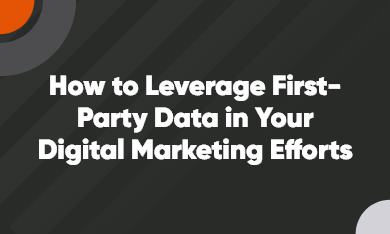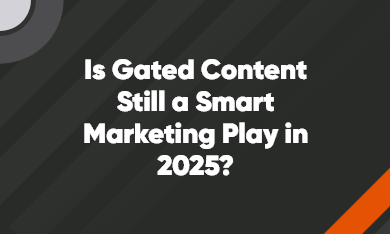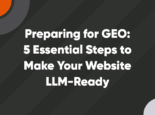
First-Party Data and Email: Why Email Marketing Should Be at the Center of Your Strategy
As marketers, we love chasing the next best thing: new channels, new AI tools, trendy tactics. But in the pursuit of what’s next, we can’t afford to overlook the proven strategies that actually drive results. If you’re not building your marketing strategy on a strong foundation of first-party data, you’re risking poor ROI, declining engagement, and wasted time chasing the wrong leads. Especially now, with growing privacy concerns and tighter regulations. Email marketing remains one of the most powerful tools you have for owning and activating first-party data.
Why first-party data matters for email
First-party data is the information your audience willingly and directly shares with you. It’s accurate, permission-based, and fully owned by your brand. That makes it one of the most valuable assets in a privacy-first marketing world.
In email marketing, this data fuels your ability to deliver relevant, personalized, and high-performing campaigns. It helps you understand your audience’s behaviors, preferences, and intent without relying on third-party tracking.
Examples of first-party data:
- Email addresses collected through on-site forms
- Purchase history from your store
- Page views and clicks from your website or emails
- Survey responses and live chat transcripts
- Any data logged in your CRM from direct user actions
First-party data makes your email strategy smarter, more efficient, and more effective. It’s the starting point for marketing that actually connects.
Email is a first-party data powerhouse
Email stands out from every other marketing channel for one simple reason: it’s yours. Your list is opt-in, meaning your audience has already given you permission to show up in their inbox. That level of trust is hard to beat and incredibly valuable.
Unlike social or paid channels, there’s no algorithm in the way. You get direct access to your audience, and every click, open, and preference feeds into your CRM. That’s the kind of insight that powers better segmentation and stronger engagement.
You can use this data in powerful ways. Let’s say someone clicks on content about a specific product. You can automatically trigger a follow-up series based on that interest. If a customer purchases a high-value item, your email strategy can guide them through onboarding, offer educational content, or prompt a review. For leads who go quiet, you can build re-engagement journeys that are timely and personalized. These are just a few ways email becomes a living, breathing extension of your first-party data.
Strengthen your first-party data through email
Getting the most out of your email marketing data starts with collecting it the right way and putting it to work. Begin with smart forms and progressive profiling that don’t ask for everything up front. Instead, start simple and gradually gather more information as users engage deeper with your content.
Next, focus on segmentation based on behavior like clicks, opens, and downloads to shape your content and messaging. Stop blasting everyone with the same generic emails and tailor your outreach to what each segment cares about.
Automate follow-ups with triggered workflows using tools like HubSpot that respond to engagement, interests, or inactivity. From welcome workflows to abandoned cart workflows, there are so many ways to personalize the experience and engage your audience.
And never forget to offer real value. People won’t sign up just for the sake of it. Lead magnets, exclusive content, early access, or something meaningful must be part of your strategy to motivate them to opt in.
Evaluating email data and first-party KPIs
Collecting first-party data is just the beginning. To get the most value, you need to track the right metrics and continuously evaluate data quality.
Start by assessing the completeness of your data. Do you have basic fields like name, email, and location? Have you collected behavioral data like click patterns, purchase history, or content preferences? Are there clear gaps in what you know about your audience?
Next, look at list health. Track growth rate, unsubscribe rate, and bounce rate to ensure your audience is engaged and your list is clean. High unsubscribe or spam complaint rates may indicate your content is not aligned with expectations.
Engagement metrics like open rate, click-through rate, and conversion rate remain useful. But when paired with first-party insights such as time between emails and purchases or responses to different content types, they become far more actionable.
Finally, consider measuring data activation. Are you using your first-party data to improve campaigns, refine segmentation, or personalize content? If not, you're sitting on valuable insights you haven’t tapped yet.
How email connects to every part of your strategy
Now that you’re harnessing first-party data through email, your strategy shouldn’t live in a silo. Instead, it should power everything else you’re doing, putting that valuable data to work across every channel and touchpoint.
- Feed paid media with precise audiences: Use email engagement and purchase data to create lookalike or retargeting audiences on platforms like Facebook and Google, ensuring your paid ads reach the most qualified prospects and that you're maximizing your ad spend.
- Trigger timely sales outreach: When a subscriber shows high intent signals, such as multiple product page visits or cart abandonment, automatically alert sales reps to follow up with personalized outreach.
- Inform content creation with segmentation insights: Analyze email engagement by segment to identify the topics or offers that resonate most, then tailor your blog, social, and video content to match these preferences.
- Nurture leads and customers with automated workflows: Design multi-step campaigns that respond to subscriber behavior, like sending an educational series after a webinar signup or recommending complimentary products post-purchase.
Email supports the entire lifecycle, from awareness and acquisition to conversion and long-term retention. A welcome series can warm up new leads. A behavior-based nurture flow can convert them into customers. And smart post-purchase emails can keep them engaged and coming back. When you integrate email with your CRM, marketing automation, and sales tools, it becomes a bridge between marketing, sales, and service.
Using first-party data the right way
Owning your data means you’re responsible for how you use it. Transparency and respect are critical.
With privacy laws tightening and third-party cookies disappearing, brands must get clear, explicit consent. Double opt-in, clear sign-up explanations, preference management, and honoring unsubscribes are essential best practices that help prevent spam complaints and protect your sender score.
First-party data only works if your audience wants to hear from you and your emails reach their inbox.
Future-proof your marketing with email
You can’t rely on borrowed data anymore. The future of third-party cookies remains uncertain, ad platforms are tightening restrictions, and privacy laws continue to evolve. The brands that will come out ahead are the ones that own their data and know how to use it effectively. Email remains one of the most reliable channels to do just that.
Build your lists, segment thoughtfully, and nurture your audience. Let email carry the load and let your first-party data fuel every aspect of your marketing. Our team can help you build an email marketing program that nurtures, engages, and converts your audience. Reach out to get started.

Molly McLay
Author
Molly McLay
Categories
Date
Explore with AI
Join Our Newsletter


How to Leverage First-Party Data in Your Digital Marketing Efforts


Is Gated Content Still a Smart Marketing Play in 2025?


